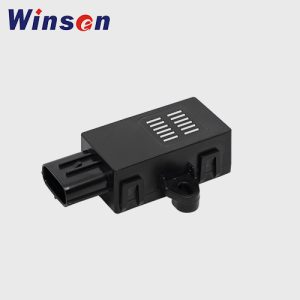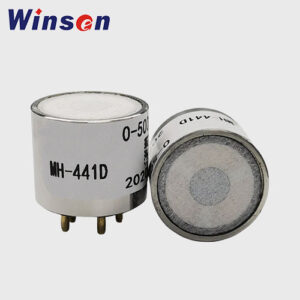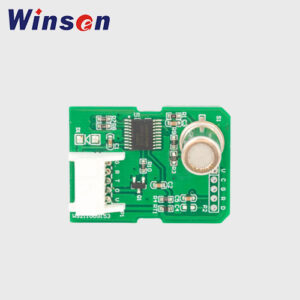
1. Introduction
In response to environmental and regulatory pressures, the HVAC and refrigeration industries have increasingly turned to מקררים טבעיים וכן low-GWP synthetic refrigerants. Among them, A3 refrigerants stand out due to their zero ozone depletion potential (ODP) וכן extremely low global warming potential (GWP). However, they are classified as highly flammable, which introduces serious safety considerations.
To mitigate the risks associated with A3 refrigerants, gas detection sensors play a critical role. These sensors enable real-time monitoring, leak detection, and integration with control systems to prevent accidents and ensure compliance with international safety standards.
This article explores the technical foundations, sensor types, applications, and regulatory requirements for A3 refrigerant detection systems in detail.
2. What Are A3 Refrigerants?
2.1 ASHRAE Classification Overview
The American Society of Heating, Refrigerating and Air-Conditioning Engineers (ASHRAE) classifies refrigerants based on:
- רַעֲלָנוּת (A = lower toxicity, B = higher toxicity)
- דְלִיקוּת
- Class 1: No flame propagation
- Class 2L: דליקה קלה
- Class 2: Flammable
- Class 3: Highly flammable
Thus, A3 refrigerants are those that are low in toxicity וכן highly flammableו
2.2 Common A3 Refrigerants
| קירור | שם כימי | GWP | Boiling Point (°C) | יישומים |
|---|---|---|---|---|
| R-290 | Propane | ~3 | -42.1 | Domestic/commercial refrigeration, A/C |
| R-600A | Isobutane | ~3 | -11.7 | Household refrigerators |
| R-1270 | Propylene (propylene) | ~2 | -47.7 | Industrial chillers |
| R-170 | Ethane | ~5 | -88.6 | Cryogenics, ultra-low temp |
| R-1150 | Ethylene | ~1 | -103.7 | Specialized cooling systems |
These refrigerants offer exceptional thermodynamic performance and climate benefits, making them attractive alternatives to HFCs and HCFCs.
3. Why A3 Refrigerant Detection Is Crucial
3.1 Flammability Risks
A3 refrigerants have:
- Low lower flammability limits (LFLs): ~2.1% to 3.5% by volume in air
- High flame propagation speed
- Low ignition energy (~0.25 mJ)
These properties mean that even small leaks in confined or poorly ventilated areas can lead to fire or explosion risks.
3.2 Safety Regulations
Due to the high flammability of A3 refrigerants, international and national codes require:
- Gas leak detection systems
- Ventilation activation
- Emergency shutdowns
- Alarm signaling
Regulatory bodies include:
- IEC 60335-2-89 (commercial refrigeration)
- IEC 60335-2-40 (air conditioners and heat pumps)
- EN 378
- ASHRAE 15 and 34
- ISO 5149
3.3 System Design Compliance
Sensors are essential for:
- Limiting charge sizes
- Allowing installation in occupied spaces
- Enabling early intervention before flammable mixtures form
4. Technologies Used in A3 Refrigerant Detection
4.1 Catalytic Bead Sensors (Pellistors)
עיקרון עבודה: Measures change in resistance due to oxidation of flammable gas on a catalytic surface.
- יתרונות:
- Widely used for hydrocarbons
- Fast response (<10 sec)
- Cost-effective
- חסרונות:
- Consumes combustible gas
- Affected by poisons (e.g., silicon, sulfur)
- Requires oxygen to operate
4.2 Infrared (NDIR) Sensors
עיקרון עבודה: Detects gas via infrared absorption at characteristic wavelengths.
- יתרונות:
- High accuracy and stability
- Selectivity for specific gases
- Not oxygen-dependent
- חסרונות:
- Higher cost
- Slower response (15–30 sec)
- Needs periodic calibration
4.3 Metal Oxide Semiconductor (MOS)
עיקרון עבודה: Gas interaction with semiconductor surface changes its resistance.
- יתרונות:
- Good sensitivity
- Low cost
- Durable in harsh environments
- חסרונות:
- Cross-sensitivity
- Prone to drift
- Requires frequent recalibration
4.4 Photoacoustic Spectroscopy
- Advanced IR technique
- Extremely high sensitivity
- Used in critical environments
5. Sensor Performance Parameters
| Parameter | Typical Range / Value |
|---|---|
| Detection Range | 0–100% LFL |
| Resolution | 100 ppm or 1% LFL |
| Response Time (T90) | <30 seconds |
| Accuracy | ±5% of full scale |
| Operating Temp | -20°C to +55°C |
| Humidity Range | 0–95% RH (non-condensing) |
| Output Signal | 4–20 mA, Modbus, RS485, Relay |
| Lifetime | 3–10 years (technology-dependent) |
| Certifications | ATEX, UL, IECEx, CE |
6. Installation and Placement Guidelines
6.1 Sensor Location
Since A3 refrigerants are heavier than air, detectors should be:
- Near floor level (≤300 mm)
- Close to leak sources (compressors, joints, valves)
- In occupied zones or mechanical enclosures
- Away from direct ventilation airflow
6.2 Quantity and Coverage
- Use one sensor per 10–20 m² in confined areas
- Ensure overlapping detection zones in large rooms
- Consider natural and mechanical ventilation paths
6.3 Integration with Systems
- Alarm signaling (visual, audible)
- Activate ventilation fans
- Disable compressors
- Alert building management system (BMS)
- Interface with fire detection systems
7. Applications of A3 Refrigerant Sensors
7.1 Household Appliances
- R-600A widely used in fridges
- Sensor integration in testing and production lines
- Ensures safety in compact sealed systems
7.2 Commercial Refrigeration
- R-290 for display cabinets, bottle coolers
- Detectors in condensing units, cold rooms
- Complies with IEC 60335-2-89
7.3 Air Conditioning Units
- Mini-split and portable A/C systems using R-290
- Room-based leak detectors required in some cases
7.4 Industrial Cooling Systems
- R-1270 in chillers, process cooling
- Multiple detectors monitor large-scale installations
7.5 Automotive and Transport Refrigeration
- Systems using hydrocarbons for lightweight cooling
- Detects leaks in cabin and cargo compartments
8. Certification and Compliance Standards
| Standard | Relevance |
|---|---|
| IEC 60335-2-89 | Commercial refrigeration equipment |
| IEC 60335-2-40 | Heat pumps and A/C systems |
| EN 378 | Refrigerating systems and safety |
| ISO 5149 | Safety and environmental requirements |
| ASHRAE 15 & 34 | Classification and safety |
| UL 60335 | North American safety standards |
| ATEX / IECEx | Explosive atmosphere certification |
9. Sensor Output and Connectivity Options
| Output Type | Purpose |
|---|---|
| Analog (4–20 mA / 0–10 V) | Integration with PLCs, HVAC controls |
| RS485 / Modbus | Multi-sensor networks, diagnostics |
| Relay Outputs | Triggers alarms, fans, solenoids |
| IoT (LoRa, ZigBee, NB-IoT) | Cloud and remote monitoring |
| LED Indicators | Local visual feedback |
Smart sensors often offer:
- Auto-calibration
- Self-diagnostics
- Remote firmware updates
10. Challenges in A3 Gas Detection and Solutions
| Challenge | Mitigation Strategy |
|---|---|
| Sensor poisoning | Use poison-resistant catalytic sensors |
| High humidity environments | Choose sensors rated for 95% RH |
| Cross-sensitivity with VOCs | Use NDIR or filtered sensors |
| False alarms from cooking gases | Adjust alarm thresholds and response logic |
| Mechanical damage (vibration) | Use ruggedized housings |
| Harsh industrial environments | IP65/IP66 enclosures, temperature ratings |
11. Case Study: Supermarket Cold Room Safety
Scenario: A large supermarket chain adopts propane (R-290) in walk-in cold rooms.
Implementation:
- Catalytic sensors at floor level
- Alarm triggered at 20% LFL
- Automatic fan activation at 30% LFL
- System shutdown at 50% LFL
- Integration with central alarm system
Outcome:
- Zero safety incidents over 3 years
- Passed all IEC compliance audits
- Reduced refrigerant loss and downtime
12. Frequently Asked Questions (FAQ)
Q1: Why are A3 refrigerants considered dangerous?
Because of their high flammability, low ignition energy, and high flame speed. Proper leak detection is essential for safe use.
Q2: What is the best detection technology for R-290?
NDIR and catalytic bead sensors are both effective. NDIR offers higher specificity, while catalytic sensors are faster and more cost-efficient.
Q3: Do A3 refrigerant sensors require frequent calibration?
Yes. Catalytic and MOS sensors should be calibrated every 6–12 months. NDIR may require less frequent adjustment.
Q4: Can these sensors be used outdoors?
Yes, with proper IP-rated enclosures וכן weather protection, they can operate in outdoor condensing units or rooftop systems.
Q5: Are A3 sensors mandatory by law?
In many jurisdictions, yes, especially when refrigerant charge exceeds limits specified in IEC 60335 or ASHRAE 15.
13. Conclusion
A3 refrigerants offer unparalleled environmental benefits, but their high flammability demands serious attention to safety. A3 refrigerant detection sensors are indispensable components in modern refrigeration and air conditioning systems. From residential units to commercial cold chains, these sensors play a vital role in preventing accidents, ensuring compliance, and supporting the transition to sustainable cooling.
Whether based on הוא n- catalytic bead, or MOS technologies, the right sensor, installed correctly and maintained regularly, provides peace of mind and operational safety. As natural refrigerants gain ground globally, robust gas detection infrastructure will be key to unlocking their full potential.






